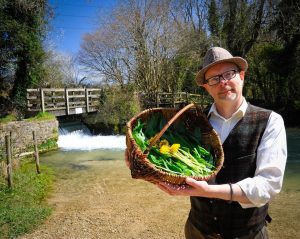TEN MUSHROOMS OF WINTER
(from November to February in the UK)
Fred Gillam
Field Blewit
Lepista personata
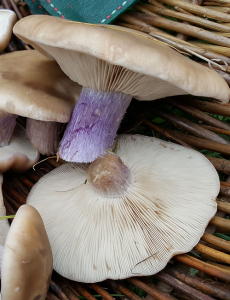 For a long time this mushroom has been in my top 5 and was my grandfather’s favourite! They have an exquisite depth of flavour but must be well cooked, as like many wild mushrooms, to consume them undercooked may lead to gastric upset.
For a long time this mushroom has been in my top 5 and was my grandfather’s favourite! They have an exquisite depth of flavour but must be well cooked, as like many wild mushrooms, to consume them undercooked may lead to gastric upset.
FEATURES
CAP: Pale cream-buff to dark tan, to 12.5 cm across.
GILLS: Whitish buff at first, later tan. Sinuate.
STEM: Stout, flushed with blue-purple when fresh, no ring or vulva present.
SPORE PRINT: Pale pinkish-buff.
AROMA: Perfumed.
FRUITING PERIOD: Late November to mid January.
HABIT: In rings in grassland, saprophytic.
HABITAT: Unimproved pastureland and parkland that is moist but not waterlogged. Sometimes neglected playing fields. Look for the presence of animal dung and plenty of broad-leaved weed species.
CONSERVATION NOTES: Though still quite common in the UK, loss of traditional pasture habitat is likely to significantly impact colonies in the future.
Winter chanterelle
Craterellus tubaeformis
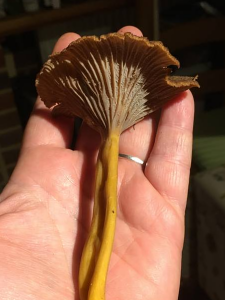
One of the most popular commercially gathered wild mushrooms throughout Europe. It takes a long time to gather any amount as they are very light. They also blend in perfectly with their leafy surroundings making them very difficult to see. Blink and they are gone, you will have to find them all over again!
FEATURES
(the one illustrated is particularly large)
CAP: Small and convex, later funnel shaped, varying shades of ‘dead leaf’ brown.
GILLS: No true blades, rather ‘false gills’ which are wavy ridges, sometimes interconnected, at first golden ochre, later grey.
STEM: Yellow to yellow-brown, waxy, tubular and lacking a ring. Often wrinkled and twisted.
SPORE PRINT: Whitish.
AROMA: Feint, sllightly fruity, apricot.
FRUITING PERIOD: Mid November to late January
HABITAT: Under conifers, birch and beech – where they are most difficult to spot – in locally acidic soils, look for sphagnum moss. They like to cluster around fallen branches and old stumps.
CONSERVATION NOTES: Currently not threatened and very common in conifer plantations.
Herald of winter
Hygrophorus hypothejus
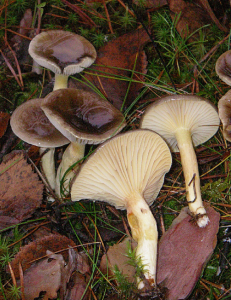
(Image source: Public domain, Commons)
A very attractive member of the woodwax clan. It is not often seen on the menu in western Europe though it is traded as a food item in northern Scandinavia. It is watery, giving out a lot of juice when cooked, which should be cooked off until the mushrooms begin to brown and become crispy at the edges.
FEATURES
CAP: 3 to 6 cm across, slimy when wet.
GILLS: Pale yellow, widely spaced, adnate or slightly decurrent.
STEM: Cylindrical, slightly narrowing below cap, pale yellow, no ring.
SPORE PRINT: White.
AROMA: Indistinct.
FRUITING PERIOD: After the first frosts throughout December.
HABIT: In loose swarms and small clusters.
HABITAT: Under conifers, particularly pine.
CONSERVATION NOTES: Look out for this species in plantation forestry.
Snowy waxcap
Cuphophyllus virgineus
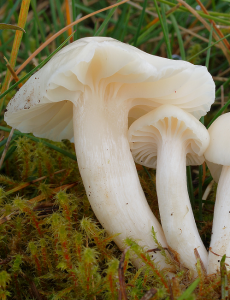
(Source image: 2007-10-20_Cuphophyllus_virgineus_CCSASA3.0U
Andreas_Kunze, Commons)
After a bout of cold weather it can sometimes look as if it has snowed with the snowy waxcap appearing everywhere. Remember to leave some as food for invertebrates who will also be looking for food to keep them going through the winter.
FEATURES
CAP: 2 to 6 cm. Domed at first, eventually becoming flattened, even convex or funnel like.
GILLS: Widely spaced, decurrent and waxy looking.
STEM: Cylindrical and white, often slightly curved and slightly darker near the base. No ring.
SPORE PRINT: White.
AROMA: Indistinct.
FRUITING PERIOD: Late autumn and early winter.
HABIT: Occurring singly or in small clusters.
HABITAT: Unimproved grassland, mature pasture, parkland, churchyards and lawns, preferring acid soils.
CONSERVATION NOTES:The commonest of wax caps but should only be picked where plentiful as its habitat is becoming increasingly scarce.
Meadow waxcap
Cuphophyllus pratensis
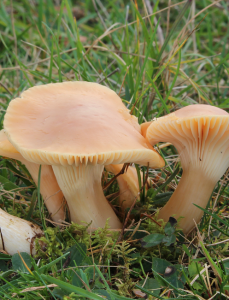
(Image source: Orangefarbene_Wiesen-Ellerling_Cuphophyllus_pratensis
Hygrocybe_pratensis_CCA3.0U_H.Krisp, Commons)
This is one of the commoner waxcaps, large in size and full in flavour. Not many people eat them but I suspect this is more cultural than anything else. They are very good. They require long cooking to cook off the juices so perhaps this is another reason that many people decide to overlook them.
FEATURES
CAP: 2 to 7 cm across, sometimes much larger. Yellowish to peachy-buff. Waxy looking though dry to the touch except in wet weather. At first domed with a slight raised central umbo, becoming flattened and turning up at the edges with age.
GILLS: White when young, gradually more the colour of the cap. Widely spaced, decurrent, thick and waxy looking, often with visible ridges at right angles that join adjacent gills.
STEM: Chunky, cylindrical but rarely straight. Similar in colour to the cap. No ring.
SPORE PRINT: White.
AROMA: Indistinct or a little sweet.
FRUITING PERIOD: Autumn and early winter.
HABIT: Grows singly and in small clusters.
HABITAT: Unimproved grassland, pasture, meadows, parkland, churchyards.
CONSERVATION NOTES: A fairly abundant waxcap. This edible mushroom should only be gathered where it is plentiful due to loss of it’s preferred habitats.
Common oyster
Pleurotus ostreatus
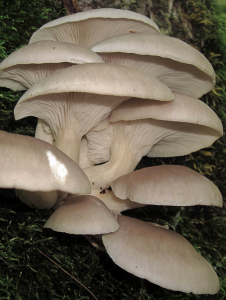
(Image source: Pleurotus_ostreatus_-_Pleurote_en_huître_cropped_CCAG2.0_
Charl-de-mille-isles, Commons)
Almost everyone knows the oyster mushroom yet few have tried them from the wild – they are far tastier! Few also realise that they come with many health benefits, being protective for the heart, containing natural cholesterol lowering statins and (like all outdoor grown mushrooms) they are rich in vitamin D.
FEATURES
CAP: Pale grey to slate grey, blue grey or even dark brown.
GILLS: Decurrent, whitish at first, later very pale buff.
STEM: Whitish and usually eccentric – meaning joining the cap near the edge rather than in the centre. Firm and tough with no ring. Downy at the very base.
SPORE PRINT: White.
AROMA: Mushroomy.
FRUITING PERIOD: Throughout the year but often fruits 2 or 3 times throughout the winter on the same log.
HABIT: In clusters growing from decaying wood on living and dead trees, often originating from a common base (cespitose).
HABITAT: Fairly gregarious on broadleaved trees but prefers beech above all others.
CONSERVATION NOTES: Very, very common and an important part of the great cycle that feeds nutrients from decaying trees back into the forest floor.
Velvet shank
Flammulina velutipes
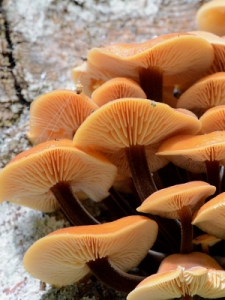
(Image source: flammulina_velutipes_on_
fagus_sylvatica_2_sml_Le_roj_
CCSASA2-0, Commons)
In southern England these appeared in great numbers on the dead elms after the ravages of Dutch elm disease almost detroyed the native elm population. They are still very common on fallen trees and stumps. The caps can be very slimy and if you have patience are better peeled by scraping with a very sharp knife. They are the same species as the white cultivated ‘enoki’ mushroom, but the taste and texture is completely different!
FEATURES
CAP: Small, 2 to 5 cm across, slimy especially when wet and yellow-orange to pale brown coloured, often darker towards the centre.
GILLS: Off-white, adnexed – slightly attached to the stem.
STEM: The stem has a velvety texture giving rise to the name, especially lower down. It ranges from pale brown to dark reddish-brown, when it resembles antler velvet. No ring.
SPORE PRINT: White.
AROMA: Feintly sweet / fruity.
FRUITING PERIOD: After the first frosts until Late February in some years.
HABIT: In dense clusters (cespitose) on rotting wood and fallen logs.
HABITAT: Hedge bottoms and in woodland, on fallen timber, standing rotting wood and tree stumps.
CONSERVATION NOTES: This is a very very common fungus. A winter food source for some woodland invertebrates.
Wood ear
Auricularia auricula-judae
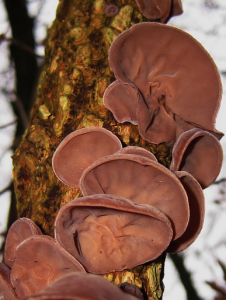
(Image source: Auricularia_auricula-judae__CCA3.0U_Henk_Monster, Commons)
Sometimes used as a survival food on the hoof, this mushroom is actually pretty respectable in Asian cookery such as stir fry’s and noodle dishes. It benefits from being marinated in tamari or a miso sauce and MUST be shredded finely if you intend to fry it as otherwise it may fill with gas and explode all over you! A rich source of antioxidant fungal melanin which is very good for protecting cells from radiation damage and oxidative stress. Elder trees are the place to look.
FEATURES
CAP: 2 to 8 cm across. Dark tan with a purple hue. Downy on the outer surface. A fleshy, jelly like, ear-shaped protuberance.
GILLS: No gills present.
STEM: No stem to speak of.
SPORE PRINT: White.
AROMA: Feint and hard to describe, damp and mushroomy.
FRUITING PERIOD: All year though can fruit very prolifically indeed during mild spells in later winter.
HABIT: In clusters on the damaged of wood of living trees and on recently fallen branches. Preferring elder trees above all others.
HABITAT: Hedges, woodland edges, rides and copses with the presence of elder trees.
CONSERVATION NOTES: This is a very very common fungus.
Scarlet elf cup
Sarcoscypha coccinea
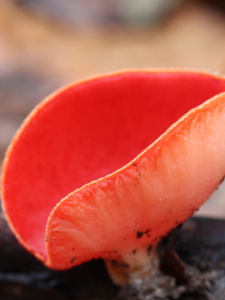
(Image source: Scarlet_Elf_Cup_-_
Sarcoscypha_coccinea_
(12746135943)_CCASA2G_Bjorn_S, Commons)
There is some debate about the edibility of this frequently occurring fungus though it is used in quite a few gourmet restaurants as a garnish or a delicate little cup for serving canapes.
FEATURES
CAP: Vivid scarlet. Pinkish and slightly downy on the underside. Cup shaped and very thin.
GILLS: No gills are present.
STEM: A very short ‘stub’ like protuberance below the cap.
SPORE PRINT: White.
AROMA: Very feint and indistinct.
FRUITING PERIOD: Late January to March but sometimes throughout the year.
HABIT: On mossy fallen logs and on buried rotting wood and twigs.
HABITAT: It likes boggy and poorly drained areas of woodland.
CONSERVATION NOTES: If you decide to try this mushroom please pick only a few as it typically occurs in small colonies and due to its debated edibility it should probably only be consumed in small quantities anyway, if at all!
Turkey tail
Trametes versiclor
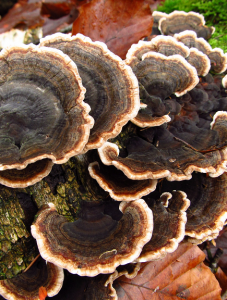
(Image source: Schmetterlingstramete_
(Trametes_versicolor)_-_hms(1)_CCSASA3.0_
Hans-Martin_Scheibner, Commons)
This very common and pretty fungus comes in a wide variety of colour variants. It has been the subject of a number of investigations and clinical trials and is used medicinally (after correct preparation) to treat a weakened immune system. It is used by medical herbalists and is the source of ‘Krestin’, PSP and PSK; adjuncts that are in the treatment of certain types of cancer. Turkey tail mushroom is non-toxic, but not used as a food because it is exceedingly tough! The fruitbodies have been simmered as the base for a medicinal broth when suffering from chest infections and influenza.
FEATURES
CAP: Very thin, 2 to 6.5 cm across and typically fan-shaped. Not attached to a stem. Upper side with concentric bands of different colours and slightly velvety. The outer band is cream in colour and can be wide or so thin it is hardly visible.
GILLS: There are no gills. Very tiny pores are visible on careful inspection of the under-surface and these are white to creamy-white.
SPORE PRINT: Whitish.
AROMA: Indistinct or faintly of rotting bark.
FRUITING PERIOD: Various times of the year when wood on the forest floor is damp, even in mid-winter.
HABIT: In tiered tightly formed groups on small branches, fallen trunks, tree-stumps, sometimes on dying trunks and even growing out of park benches! When growing on fallen logs it sometimes also forms a continuous crust that spreads underneath with the tiered fruit bodies growing out on both sides. Mushrooms forming on top of a stump can be rosette shaped.
HABITAT: Woodland, parkland, hedges and gardens. Anywhere that trees and woody shrubs can grow.
CONSERVATION NOTES: A valuable part of the deadwood decomposing ecosystem. This fungus breaks down it’s substrate material and moves on very quickly so it is important to ensure a quantity of dead branch material lays on the forest floor and not to ‘tidy up’ after storms,wind-throw and woodland felling or thinning.
The Wild Side of Life also runs a Medicinal Mushrooms Weekend Workshop which is ideally suited for those with an interest in health, nutrition and the use of herbs, whether amateur or professional (click for details)
IMPORTANT: Never eat any wild mushroom or plant without being 100% certain of its identification… ok, I know you all know that already 😉
If you enjoyed this article, maybe you would enjoy a foraging course at The Wild Side of Life…
Our one day courses are available in the spring (shoots and herbs focused) and autumn (mushroom focused). Depending on the season they include cooking with spring shoots, flowers and herbs, mushroom identification and cookery, all delivered within a mix covering medical uses, nutritional knowledge, ecology and folklore. They are tailored to bring you an exciting experience that will delight those with a culinary interest or an interest in nature… and they make perfect gifts!
Our 12 month Club memberships…
The Spring & Summer Forager’s Club and the Secret Sunday Mushroom Club, feature 4 days of field visits, an exclusive members only ID forum with expert mentoring and extensive learning resources. Members will learn the skills needed for identification and to avoid picking poisonous look-alikes, whilst foraging sustainably and staying within the law.
The Wild Side of Life was voted Best Food Foraging Education Provider in the Food & Drink Awards and is featured by BBC Countryfile Magazine in the UK Foraging Courses Top 10. Fred Gillam (also known as ‘Fred the Forager’) has appeared on national television foraging for mushrooms with Gino D’Acampo, on BBC radio 2 with Jeremy Vine and on the Farming Today programme. He is the author of Poisonous Plants in Great Britain.

